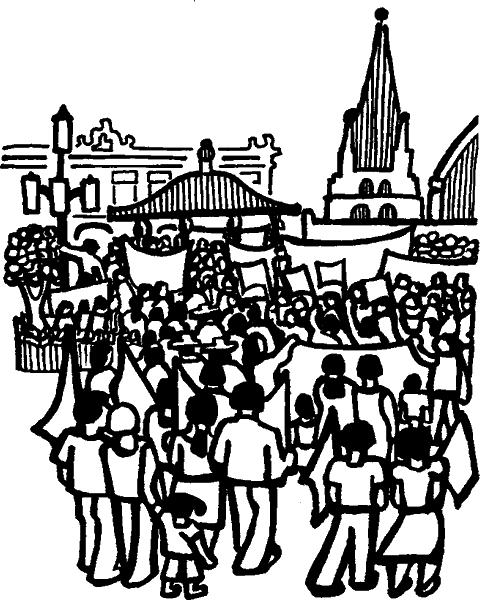|
We
cannot expect the international
community or institutions
to solve our problems,
until we clean up our
own backyard. But the
basic question remains
in the meantime: What
is the Declaration going
to give to the ordinary
people whose basic human
rights are constantly
violated in every possible
way?
-Aleksanda
Visacki
Office worker
Belgrade, Serbia
|
 |
Part
I: Human Rights Fundamentals
I.
Background Resources and Materials
Felice,
William F. Taking Suffering Seriously: The Importance
of Collective Human Rights, SUNY Series in Global Conflict
and Peace Education. New York: State University of New York,
1996.
This
is a serious and well-written examination of the evolution
and development of human rights concepts in international
relations. Felice discusses the tensions that exist between
individual and collective human rights in regards to race,
gender, sexuality, and self-determination. Felice argues
for a method to ensure human rights in an international
arena which relies on an agreement on particular international
documents, such as the Universal Declaration of Human
Rights, that exemplify international human rights.
Newman,
Frank and David Weissbrodt. International Human Rights:
Law, Policy, and Process, 2nd ed. Cincinnati: Anderson
Publishing Co.,1996.
This
book provides an in-depth introduction to the history
of international human rights law, policy, and process.
The book presents case studies for discussion and role
play activities in the classroom.
Rethinking
Schools. Rethinking our Classrooms: Teaching for Equity
and Justice. Milwaukee, WI: Rethinking Schools, Ltd.,
1994.
A
collection of articles describing examples of successful
classroom practices in teaching social justice issues.
It includes a collection of teaching ideas and thoughtful
essays on "Rethinking our Assumptions" as well
as a resource section of curricula, books, videos, and
journals.
United
Nations Association of the United States of America. Basic
Facts About the United Nations. New York: United Nations
Publications, 1992.
This
book contains a general introduction to the role and function
of the United Nations and related agencies, highlighting
and outlining main objectives and achievements. The text
includes the charter and statutes of the International
Code of Justice.
Whalen,
Lucille. Human Rights: A Reference Handbook. Santa
Barbara, CA: ABC-CLIO, Inc., 1990.
The
ideal resource for any course on human rights, this handbook
offers a history of human rights in the twentieth century,
biographical sketches of human rights heroes, and an annotated
listing of human rights organizations, books, periodicals,
and films, as well as electronic information sources such
as computer networks and databases. The final section
includes the most significant international human rights
declarations and conventions (excluding the Conventions
on the Rights of the Child and the Women’s Convention,
which were ratified by the U.N. after the handbook’s
publication date).
Brown,
Margot. Our World, Our Rights: Teaching about Rights
and Responsibilities in the Primary School. Amnesty
International, UK 1996.
This
curriculum offers innovative strategies and activities
for teaching about the UDHR in upper elementary school.
Although written for British schools, all of the activities
are easily adapted to a US context. Activities address
human rights in the family, the classroom, the school,
and the wider community. Handsome illustrations and useful
support information.
Elliot,
RoAnne. WE: Lessons on Equal Worth and Dignity.
Minneapolis, MN: The United Nations Association of Minnesota,
1992.
This
middle school curriculum offers the United Nation’s
work as a model for students to create a more tolerant
world. The lessons contained in this curriculum provide
opportunities for students to develop knowledge of international
relations, highlight student awareness of intolerant behavior,
and help students to develop tolerance skills.
Gonzalez,
Susan. WE: Lessons on Equal Worth and Dignity.
Minneapolis, MN: The United Nations Association of Minnesota,
1997.
This
elementary school curriculum offers opportunity for students
to discuss the issues related to race, ethnicity, and
religion in a sensitive and caring manner. It features
the United Nations work to create a more tolerant world.
Nu�ez,
Luc�a. An Agenda for Peace: The Role of the United Nations.
Stanford, CA: Stanford Program on International and Cross-Cultural
Education, 1995. SPICE, Littlefield Center, Room 14C, Stanford
University, Stanford, CA 94305-5013. Telephone 800-578-1114.
A
curriculum guide for secondary to adult students. Includes
several learner-centered activities to introduce students
to the history, programs, and activities of the United
Nations. Uses engaging primary resources. Students analyze
the impact of UN peacemaking missions, hold a model earth
summit, and re-enact the UN Charter Conference in San
Francisco. Also includes audio tape.
Simon,
Ken. WE: Lessons on Equal Worth and Dignity, The United
Nations and Human Rights. Minneapolis, MN: The United
Nations Association of Minnesota, 1992.
Special
features of this high-school curriculum include activities
on ethnocentric thought and behavior, racism and the First
Amendment, the power of language, symbol and music, a
study of the Peace School in the Middle East, and on ongoing
diary assignment reflecting one’s own development
of "tolerance".
United
Nations. ABC, Teaching Human Rights: Practical Activities
for Primary and Secondary Schools. New York: United
Nations, 1989.
For
the teacher just beginning to teach human rights, this
booklet provides the ideal starting point. Available in
English, French, and Spanish, its activities and teaching
strategies are intended to be effective in any cultural
setting and to cover the spectrum of rights included in
the International Bill of Rights. It offers a rationale
for teaching human rights and recommends methodologies
that model fundamental concepts such as inclusiveness,
equality, and tolerance of differences.

